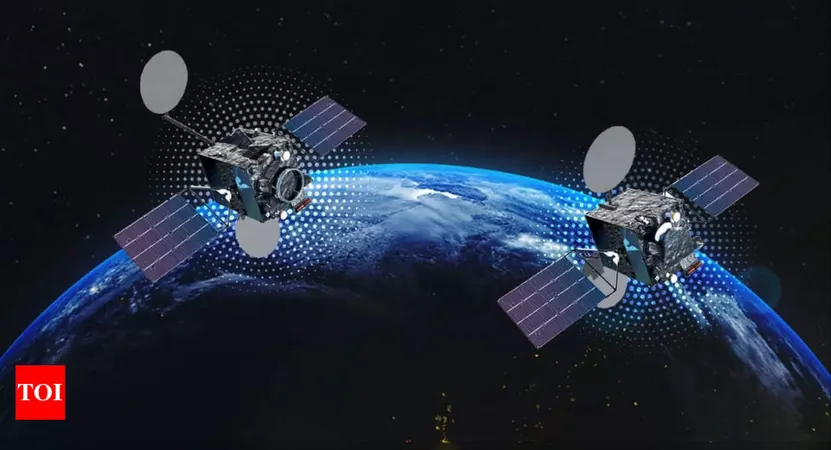
Mystery of the Wandering Satellite: UK's Oldest Spacecraft Now a 'Ticking Time Bomb'
2024-11-10
Author: Jia
Introduction
In a startling development, the UK's oldest satellite, Skynet-1A, has mysteriously relocated from its original orbit, and the circumstances surrounding this shift remain shrouded in mystery.
Background of Skynet-1A
Launched in 1969, the satellite was intended to hover over the Indian Ocean, serving as a crucial military communications relay for British forces. However, it can currently be found positioned precariously over the Americas at an altitude of approximately 22,369 miles (36,000 km).
The Mystery of its Movement
Experts hypothesize that Skynet-1A was deliberately moved in the 1970s, as natural gravitational forces would have typically directed it eastward. Yet, there’s no available documentation to clarify who was responsible for this maneuver or why it occurred.
Concerns of Collision
This uncharted territory in space raises significant concerns about the satellite's safety, as it now risks colliding with other satellites and existing space debris.
Expert Opinions
Dr. Stuart Eves, a space consultant, described Skynet-1A’s situation, stating, 'It’s now in what we call a ‘gravity well,’ wandering like a marble at the bottom of a bowl. This unfortunate position brings it dangerously close to other satellite traffic on a regular basis.' With the satellite being unresponsive, Dr. Eves pointed out, 'The risk is it might bump into something, and as it’s technically 'our' satellite, we remain responsible for its actions.'
Ongoing Questions and Investigations
The satellite's saga continues to perplex experts, as Dr. Eves has found no clues regarding its operational phase or its journey to this precarious location in the historical records. It remarkably risks encounters with space debris within a 50 km radius up to four times daily.
Historical Context
Originating from the US, Skynet-1A was constructed by the now-defunct Philco Ford aerospace company and launched via a Delta rocket by the US Air Force. A research paper by Dr. Aaron Bateman emphasizes that while Skynet-1A was integral in revolutionizing UK telecommunications, its technology was predominantly American.
Control and Management Issues
Adding to the complexity, Graham Davison, who managed Skynet-1A from RAF Oakhanger during its early days, noted, 'The Americans originally controlled the satellite in orbit. They tested all of our software against theirs, and only later did the RAF take over control.' It remains uncertain at what point this control shifted back to the US or the rationale behind such a decision.
Shift in Control
UCL PhD researcher Rachel Hill highlighted that American control over the satellite occurred during maintenance shutdowns at RAF Oakhanger, a potential factor in the satellite's relocation.
Fears of Abandonment
According to records, the last control of Skynet-1A reverted to the US after June 1977 when Oakhanger lost tracking capabilities. Consequently, experts fear that the satellite may have been abandoned in its current, hazardous position.
Warnings from Experts
Moriba Jah, an aerospace engineering professor at the University of Texas, raised alarms about the satellite’s condition. He described space debris as 'like ticking time bombs,' warning against what he calls 'super-spreader events.'
Conclusion
Despite the advanced technology we have today, the fate of Skynet-1A underscores the unresolved issues surrounding satellite debris management and the potential risks that arise from mismanaged space traffic.
Call to Action
As scientists scramble to understand this enigma, one thing is clear: if we don’t act swiftly, the wandering Skynet-1A may very well become a notorious chapter in the harrowing story of space debris.

 Brasil (PT)
Brasil (PT)
 Canada (EN)
Canada (EN)
 Chile (ES)
Chile (ES)
 España (ES)
España (ES)
 France (FR)
France (FR)
 Hong Kong (EN)
Hong Kong (EN)
 Italia (IT)
Italia (IT)
 日本 (JA)
日本 (JA)
 Magyarország (HU)
Magyarország (HU)
 Norge (NO)
Norge (NO)
 Polska (PL)
Polska (PL)
 Schweiz (DE)
Schweiz (DE)
 Singapore (EN)
Singapore (EN)
 Sverige (SV)
Sverige (SV)
 Suomi (FI)
Suomi (FI)
 Türkiye (TR)
Türkiye (TR)